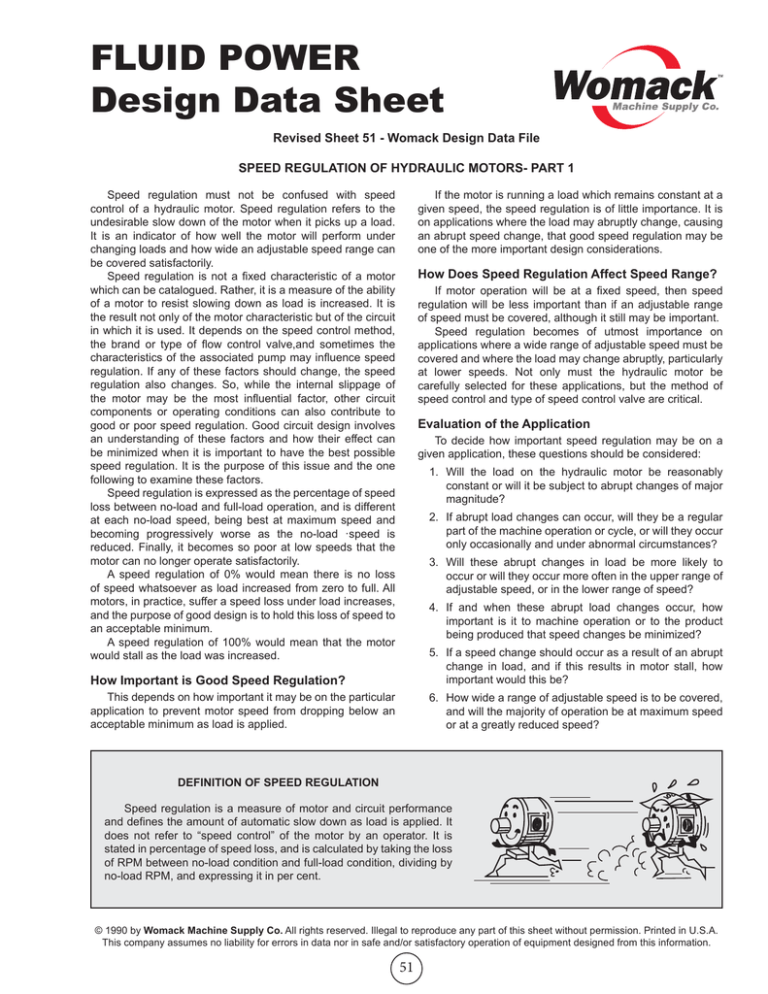
FLUID POWER
Design Data Sheet
Revised Sheet 51 - Womack Design Data File
SPEED REGULATION OF HYDRAULIC MOTORS- PART 1
Speed regulation must not be confused with speed
control of a hydraulic motor. Speed regulation refers to the
undesirable slow down of the motor when it picks up a load.
It is an indicator of how well the motor will perform under
changing loads and how wide an adjustable speed range can
be covered satisfactorily.
Speed regulation is not a fixed characteristic of a motor
which can be catalogued. Rather, it is a measure of the ability
of a motor to resist slowing down as load is increased. It is
the result not only of the motor characteristic but of the circuit
in which it is used. It depends on the speed control method,
the brand or type of flow control valve,and sometimes the
characteristics of the associated pump may influence speed
regulation. If any of these factors should change, the speed
regulation also changes. So, while the internal slippage of
the motor may be the most influential factor, other circuit
components or operating conditions can also contribute to
good or poor speed regulation. Good circuit design involves
an understanding of these factors and how their effect can
be minimized when it is important to have the best possible
speed regulation. It is the purpose of this issue and the one
following to examine these factors.
Speed regulation is expressed as the percentage of speed
loss between no-load and full-load operation, and is different
at each no-load speed, being best at maximum speed and
becoming progressively worse as the no-load ·speed is
reduced. Finally, it becomes so poor at low speeds that the
motor can no longer operate satisfactorily.
A speed regulation of 0% would mean there is no loss
of speed whatsoever as load increased from zero to full. All
motors, in practice, suffer a speed loss under load increases,
and the purpose of good design is to hold this loss of speed to
an acceptable minimum.
A speed regulation of 100% would mean that the motor
would stall as the load was increased.
If the motor is running a load which remains constant at a
given speed, the speed regulation is of little importance. It is
on applications where the load may abruptly change, causing
an abrupt speed change, that good speed regulation may be
one of the more important design considerations.
How Does Speed Regulation Affect Speed Range?
If motor operation will be at a fixed speed, then speed
regulation will be less important than if an adjustable range
of speed must be covered, although it still may be important.
Speed regulation becomes of utmost importance on
applications where a wide range of adjustable speed must be
covered and where the load may change abruptly, particularly
at lower speeds. Not only must the hydraulic motor be
carefully selected for these applications, but the method of
speed control and type of speed control valve are critical.
Evaluation of the Application
To decide how important speed regulation may be on a
given application, these questions should be considered:
1. Will the load on the hydraulic motor be reasonably
constant or will it be subject to abrupt changes of major
magnitude?
2. If abrupt load changes can occur, will they be a regular
part of the machine operation or cycle, or will they occur
only occasionally and under abnormal circumstances?
3. Will these abrupt changes in load be more likely to
occur or will they occur more often in the upper range of
adjustable speed, or in the lower range of speed?
4. If and when these abrupt load changes occur, how
important is it to machine operation or to the product
being produced that speed changes be minimized?
How Important is Good Speed Regulation?
5. If a speed change should occur as a result of an abrupt
change in load, and if this results in motor stall, how
important would this be?
This depends on how important it may be on the particular
application to prevent motor speed from dropping below an
acceptable minimum as load is applied.
6. How wide a range of adjustable speed is to be covered,
and will the majority of operation be at maximum speed
or at a greatly reduced speed?
DEFINITION OF SPEED REGULATION
Speed regulation is a measure of motor and circuit performance
and defines the amount of automatic slow down as load is applied. It
does not refer to “speed control” of the motor by an operator. It is
stated in percentage of speed loss, and is calculated by taking the loss
of RPM between no-load condition and full-load condition, dividing by
no-load RPM, and expressing it in per cent.
© 1990 by Womack Machine Supply Co. All rights reserved. Illegal to reproduce any part of this sheet without permission. Printed in U.S.A.
This company assumes no liability for errors in data nor in safe and/or satisfactory operation of equipment designed from this information.
51
M
K
H
F
B
D
0
L
J
200
400
G
600
800
E
1,000
50 GPM
40 GPM
25%
0%
20 GPM
10 GPM
50%
30 GPM
75%
5 GPM
OUTPUT TORQUE - Percent of Full Load
100%
1,200
A
C
1,400
1,600
1,800
2,000
MOTOR SPEED - RPM
Speed/Torque Performance of a Typical Gear - Type Hydraulic Motor
Illustration of Motor Speed Regulation
Speed Range of a Hydraulic Motor
The above graph shows the performance of a hypothetical
gear-type hydraulic motor over a speed range of 0 to 2,000
RPM, and over a load range of 0 to 100% of its rated torque
(or horsepower).
Percentage torque loading is plotted along the left side of
the graph, speed along the bottom. Motor RPM is in direct
proportion to GPM. Lines curving upward to the left show
motor performance at several GPM flows in various tests.
The leftward curvature shows a loss of speed as torque
load increases. This is due to internal slippage. Notice that
curvature of all GPM lines is about the same. This indicates
that internal slippage, in GPM, remains about the same at
all speeds but increases with load increase and is a higher
percentage at lower no-load speeds.
To interpret the graph, start at Point A. When a flow of 50
GPM is supplied to the motor, it will run at a no-load speed of
2,000 RPM. As load is increased to 100% (full load), operation
is at Point B. With pick-up of full load, motor speed has
dropped from 2,000 to 1,800 RPM because of internal loss of
working oil through clearance leakage.
According to the definition of speed regulation given on
the opposite side of this sheet, regulation would be:
To show how speed regulation becomes progressively
worse at the lower end of the speed range, the regulation
has been calculated for each of the GPM/Speed lines, and is
shown in the far right column of the chart below.
If performance charts like the above are available for the
motor under consideration for a certain application, its drop
in speed under various load increases can be estimated, and
the range of adjustable speed over which its performance will
be acceptable, can also be determined.
As a rule, a motor should be evaluated at the maximum
load change which can occur at minimum speed.
200 (speed loss) ÷ 2,000 (no-load speed) = 0.10 or 10%
PLOT OF SPEED REGULATION FOR GRAPH ABOVE
GPM
Points
No Load
Full Load
50
40
30
20
10
5
A to B
C to D
E to F
G to H
J to K
L to M
2,000 RPM
1,600 RPM
1,200 RPM
800 RPM
400 RPM
200 RPM
1,800 RPM
1,400 RPM
1,000 RPM
600 RPM
200 RPM
0 RPM
Speed
Loss
200 RPM
200 RPM
200 RPM
200 RPM
200 RPM
200 RPM
Regulation
10%
12½%
16¾%
25%
50%
100%
Note from the chart that the actual amount of speed loss,
200 RPM, is approximately constant at all speeds. A loss of
200 RPM does not affect motor performance much while it is
running at 2,000 RPM, but has a tremendous effect on performance when the motor is operating at speeds less than
800 RPM.
Example: Assume that on a certain application, and using
the motor graphed above, that a speed loss of 200 RPM is all
that can be tolerated from zero to full load when operating at a
reduced speed of 800 RPM. What is the maximum adjustable
speed range over which this motor can be operated with
acceptable performance?
Solution: Since 800 RPM is the minimum acceptable
speed of this motor under any range of adjustable speed for
the conditions stated, the only way to get a wider range of
adjustable speed is to raise the top speed. From 800 minimum
to 2,000 RPM maximum is a range of 2½:1. From 800 up to
2,400 (if possible) is a range of 3:1, etc.
Although motor performance is of prime importance for
obtaining good speed regulation, the type of speed control
circuit and the type of flow control valve used are very
important also. In the next issue we will give recommendations
for improving speed regulation when as wide a range of
adjustable speed as possible must be covered.
Published by:
WOMACK EDUCATIONAL PUBLICATIONS
Womack Machine Supply Co.
13835 Senlac Dr.
Farmers Branch, TX 75234
Tel: 800-859-9801
Fax: 214-630-5314
www.womack-educational.com




